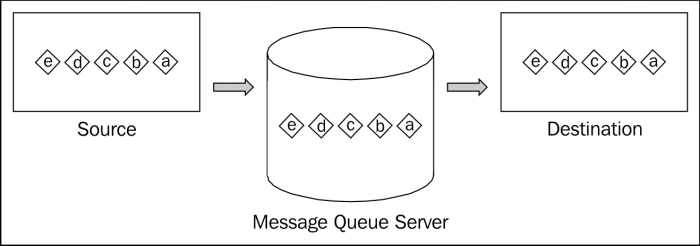A message queue, or technically a FIFO (First In First Out) queue is a fundamental and well-studied data structure. There are different queue implementations such as priority queues or double-ended queues that have different features, but the general idea is that the data is added in a queue and fetched when the data or the caller is ready.
Imagine we are using a basic in-memory queue. In case of an issue, such as power outage or a hardware failure, the entire queue could be lost. Hence, another program that expects to receive a message will not receive any messages.
However, adopting a message queue guarantees that messages will be delivered to the destination no matter what happens. Message queuing enables asynchronous communication between loosely-coupled components and also provides solid queuing consistency. In case of insufficient resources, which prevent you from immediately processing the data that is sent, you can queue them up in the message queue server that would store the data until the destination is ready to accept the messages.

Message queuing has an important role in large-scaled distributed systems and enables asynchronous communication. Let's have a quick overview on the difference between synchronous and asynchronous systems.
In ordinary synchronous systems, tasks are processed one at a time. A task is not processed until the task in-process is finished. This is the simplest way to get the job done.

Synchronous system
We could also implement this system with threads. In this case threads process each task in parallel.

Threaded synchronous system
In the threading model, threads are managed by the operating system itself on a single processor or multiple processors/cores.
Asynchronous Input/Output (AIO) allows a program to continue its execution while processing input/output requests. AIO is mandatory in real-time applications. By using AIO, we could map several tasks to a single thread.

Asynchronous system
The traditional way of programming is to start a process and wait for it to complete. The downside of this approach is that it blocks the execution of the program while there is a task in progress. However, AIO has a different approach. In AIO, a task that does not depend on the process can still continue. We will cover AIO and how to use it with ZeroMQ in depth in Chapter 2, Introduction to Sockets.
You may wonder why you would use message queue instead of handling all processes with a single-threaded queue approach or multi-threaded queue approach. Let's consider a scenario where you have a web application similar to Google Images in which you let users type some URLs. Once they submit the form, your application fetches all the images from the given URLs. However:
If you use a single-threaded queue, your application would not be able to process all the given URLs if there are too many users
If you use a multi-threaded queue approach, your application would be vulnerable to a distributed denial of service attack (DDoS)
You would lose all the given URLs in case of a hardware failure
In this scenario, you know that you need to add the given URLs into a queue and process them. So, you would need a message queuing system.



